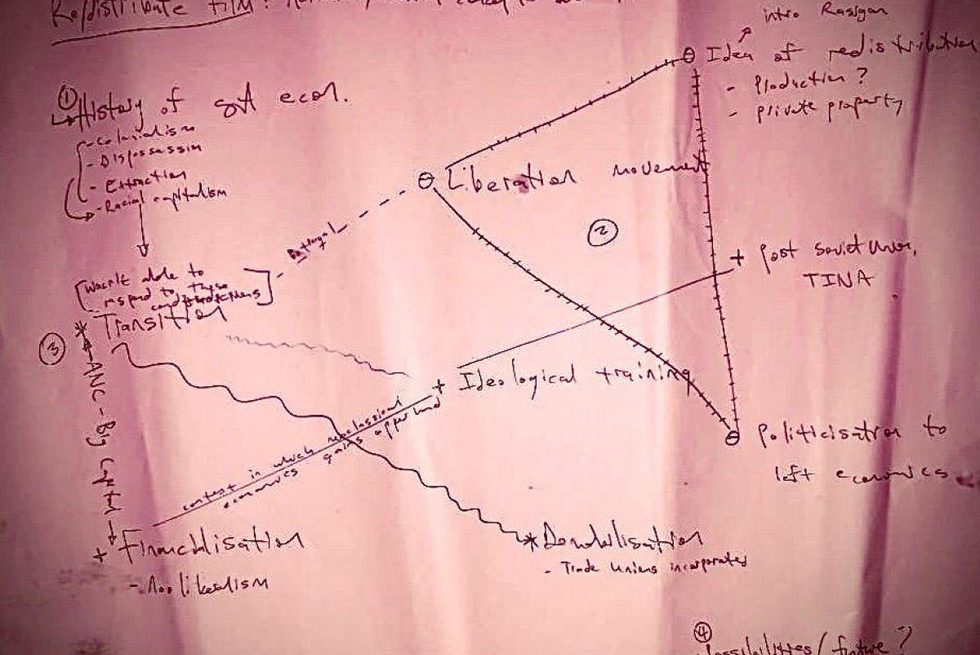Re/Distribute: Three Radical Economists on (Post)-Apartheid
From the Series: Distribute2020: An Invitation to Use, Reuse, Recombine, Cite, Relate, and Teach!
From the Series: Distribute2020: An Invitation to Use, Reuse, Recombine, Cite, Relate, and Teach!

This post offers additional materials to complement the short film, “Re/Distribute: Three Radical Economists on (Post)Apartheid · Re/distribuir: Tres economistas radicales en el (post)apartheid,” presented at Distribute2020, the biannual multimodal conference presented by the Society for Cultural Anthropology (SCA) and the Society for Visual Anthropology (SVA) in May of 2020.
This film juxtaposes 1940s archival footage of the white-controlled South African gold economy and contemporary conversations with radical economists reflecting on the nature of the South African transition to flag democracy. The archival images are posed alongside but not necessarily in direct representation of the dialogue, and so the reader is required to think obliquely about the ways histories of settler colonialism relates to the contemporary capitalist crisis. It is most directly a film about the failure of redistribution as a democratic promise in South Africa, and more generally about the history of racial capitalism.
The film was made by a collective of scholars, teachers, and cultural workers from Southern Africa who practice, very deliberately, both inside and outside of the university. We therefore encourage the screening of this session in radical collectives, community organizing spaces, and/or classroom contexts. We image that the film would be of interest to those who would like to learn about the South African transition out of formal Apartheid, racial capitalism, the neoliberal turn in political economy, and/or histories of extractivism.
If you do screen the film, please send us an email and let us know how it went. We'd love to hear from you: kgillespie@uwc.ac.za.
If you’d like a soundtrack to go with your reading, check out Asher Gamedze’s album Dialectical Soul with On the Corner Records (2020). Asher Gamedze is part of the Radical Education Network which was involved in the making of the panel.
Marx, Karl. 2010. “Primitive Accumulation (Part VIII).” In Capital, Volume I: A Critique of Political Economy, 871–940. New York: Penguin and New Left Review. Originally published in 1887.
Luxemburg, Rosa. 2003. “Militarism as a Province of Accumulation.” In The Accumulation of Capital, 434–47. London: Routledge. Originally published in 1913.
What do Marx and Luxemburg mean by “primitive accumulation”?
Kelley, Robin D. G. 2017. “Introduction.” In “Race, Capitalism, Justice,” Forum I, Boston Review Forum 1: 5–8.
Robinson, Cedric J. 2000. Black Marxism: The Making of the Black Radical Tradition. Chapel Hill: University of North Carolina Press. [Preface to the 2000 edition, and chapters 1, 2 and 5; xxvii-xxxiii, 9-43, 101–20.]
Hartman, Saidiya. 1994. “The Burdened Individuality of Freedom.” In Scenes of Subjection: Terror, Slavery and Self-making in Nineteenth-Century America, 115–24. Oxford: Oxford University Press.
Rodney, Walter. 1982. “Colonialism as a System for Underdeveloping Africa.” In How Europe Underdeveloped Africa, 205–83. Washington D.C.: Howard University Press. Originally published in 1972.
New Dawn. Podcast hosted Michael C. Dawson, founder and former Director of the Center for the Study of Race, Politics, and Culture and the John D. MacArthur Professor of Political Science and the College at the University of Chicago. https://www.raceandcapitalism.com/season-one
How do the authors describe the relationship between race and class?
Harris, Cheryl I. 1993. “Whiteness as Property.” Harvard Law Review 106, no. 8: 1710–45. (To ground yourself more in the data, read the case histories to p. 1791.)
Bhandar, Brenna. 2018. “Introduction: Property, Law and Race in the Colony” and “Conclusion: Life beyond the Boundary.” In Colonial Lives of Property: Law, Land and Racial Regimes of Ownership, 1–32, 81–200. Durham, N.C.: Duke University Press.
Why does Harris describe whiteness as “property,” and how does Bhandar use this idea to discuss colonialism?
Wolpe, Harold. 1972. “Capitalism and Cheap Labour in South Africa, from Segregation to Apartheid.” Economy and Society 1, no. 4: 425–56.
Clarno, Andy. 2017. “Racial Capitalism and Settler Colonialism.” In Neoliberal Apartheid: Palestine/Israel and South Africa after 1994. Chicago: University of Chicago Press.
Hart, Keith and Vishnu Padayachee. 2013. “A History of South African Capitalism in National and Global Perspective.” Transformation 81/82: 55–85.
Why do the authors argue that South Africa can be described as a racial capitalist society?
Linebaugh, Peter, and Marcus Rediker. 2002. “Hewers of Wood and Drawers of Water.” In The Many-Headed Hydra: Sailors, Slaves, Commoners and the Hidden History of the Revolutionary Atlantic, 36–70. Boston: Beacon Press.
Duncan, Garret Albert. 2000. “Urban Pedagogies and the Celling of Adolescents of Color.” In “Critical Resistance to the Prison-Industrial Complex,” special issue, Social Justice 27, no. 3: 29–42.
Gilmore, Ruth Wilson. 2007. “The Prison Fix.” In Golden Gulag: Prisons, Surplus, Crisis and Opposition in Globalizing California, 87–128. Berkeley: University of California Press.
Baderoon, Gabeba. 2018. “Surplus, Excess, Dirt: Slavery and the Production of Disposability in South Africa.” Social Dynamics 44, no. 2: 257–72.
Why do Linebaugh and Rediker understand “enclosure” to be a key feature of racial capitalism, and how might we think of prisons as a racial capitalist enclosure?
Federicci, Sylvia. 2004. “The Accumulation of Labor and the Degradation of Women: Constructing ‘Difference’ in the ‘Transition to Capitalism.’” In Caliban and the Witch: Women, the Body and Primitive Accumulation, 61–131. New York: Autonomedia.
Singh, Nikhil Pal. 2017. “On Race, Violence and ‘So-called Primitive Accumulation.’” In Futures of Black Radicalism, edited by Gaye Theresa Johnson and Alex Lubin, 39–58. London: Verso.
Sylvia Federicci. 2004. “The Great Caliban: The Struggle against the Rebel Body.” In Caliban and the Witch: Women, the Body and Primitive Accumulation, 133–61. New York: Autonomedia.
How do the authors apply the idea of “primitive accumulation” to race and gender?